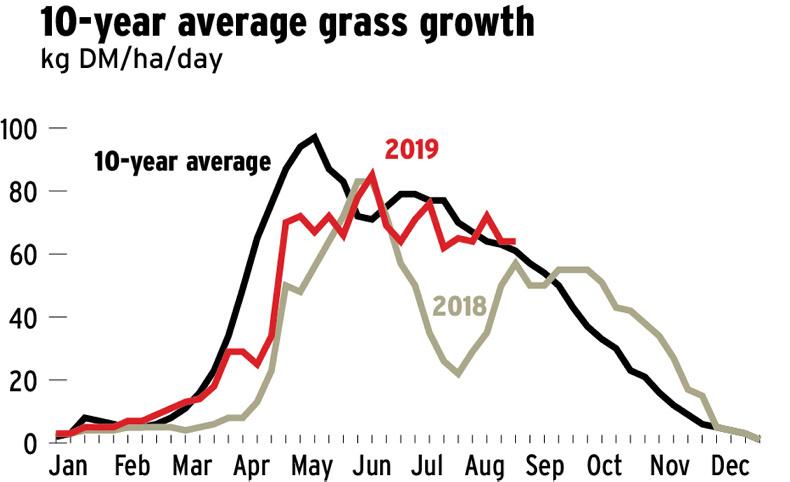Grass growth for the week averaged 64kg/day, similar to last week. Rainfall last week was two to four times above the normal for this time of year with 50mm to 80mm falling in many parts. This week has been milder and growth rates may slow a little.
Grazing conditions are still good in most areas but on heavier soils the use of multiple access points to fields may help avoid any unnecessary damage after the spell of heavy showers.

As we’re still focused on building grass, it is still important not to lose track of grass quality. How we graze out paddocks between now and the end of the year will set us up for next spring.
Keep focusing on getting good graze-outs of close to 4cm. Although you may be building covers, it is too early to be grazing cover higher than 1,600kg Dm/ha.
This applies especially to low-stocked farms, where the main grazing block stocking rate is less than 2.5 for the autumn period. Controlling grass quality and not building up high of grass covers will be your challenge.

It may be an ideal opportunity for reseeding or to take a third cut of silage on these farms. Taking out paddocks for either reseeding or silage may adjust the stocking rate closer to 2.5 LU/ha, which will make managing grass a lot easier during the autumn period as growth rates are still above average and expected to stay that way into September.
What we don’t want to see is covers of 2,500kg and greater on farms at the end of September. These covers will take longer to graze, be poorer in quality and not suitable to graze in bad weather conditions. Regrowths will also be much slower on these paddocks after grazing, which will affect the amount of grass available next spring.
Average grass growth is 64 kg/day this week.Farms with heavy soils need to make full use of grazing infrastructure in wet conditions.Low-stocked farms (<2.5 Lu/ha) need to manage grass quality for now and be careful not to build grass too early.
Grass growth for the week averaged 64kg/day, similar to last week. Rainfall last week was two to four times above the normal for this time of year with 50mm to 80mm falling in many parts. This week has been milder and growth rates may slow a little.
Grazing conditions are still good in most areas but on heavier soils the use of multiple access points to fields may help avoid any unnecessary damage after the spell of heavy showers.

As we’re still focused on building grass, it is still important not to lose track of grass quality. How we graze out paddocks between now and the end of the year will set us up for next spring.
Keep focusing on getting good graze-outs of close to 4cm. Although you may be building covers, it is too early to be grazing cover higher than 1,600kg Dm/ha.
This applies especially to low-stocked farms, where the main grazing block stocking rate is less than 2.5 for the autumn period. Controlling grass quality and not building up high of grass covers will be your challenge.

It may be an ideal opportunity for reseeding or to take a third cut of silage on these farms. Taking out paddocks for either reseeding or silage may adjust the stocking rate closer to 2.5 LU/ha, which will make managing grass a lot easier during the autumn period as growth rates are still above average and expected to stay that way into September.
What we don’t want to see is covers of 2,500kg and greater on farms at the end of September. These covers will take longer to graze, be poorer in quality and not suitable to graze in bad weather conditions. Regrowths will also be much slower on these paddocks after grazing, which will affect the amount of grass available next spring.
Average grass growth is 64 kg/day this week.Farms with heavy soils need to make full use of grazing infrastructure in wet conditions.Low-stocked farms (<2.5 Lu/ha) need to manage grass quality for now and be careful not to build grass too early. 







 This is a subscriber-only article
This is a subscriber-only article










SHARING OPTIONS: